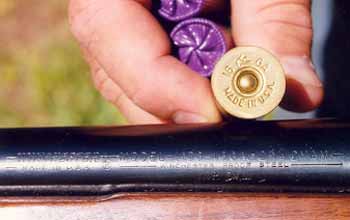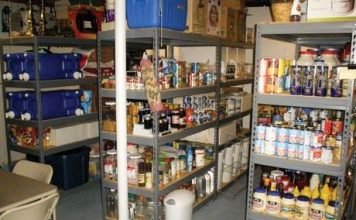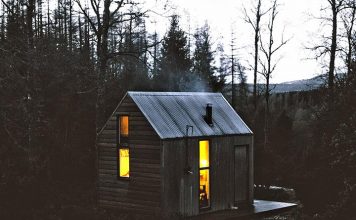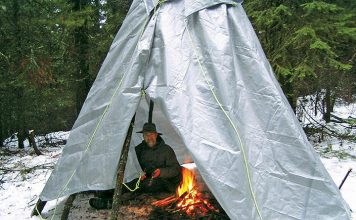 |
|
| Website Exclusive • December, 2003 |
In Part I, we began a series of refreshers on safety and proper handling of firearms. This time, we’ll examine what may be the most common firearm in rural homes: the shotgun.
Nicknamed the “smoothbore” because it has no rifling inside its barrel, the shotgun derives its given name from the fact that like muskets of old, it can fire a charge of shot pellets in a beehive cluster, and can also fire a single projectile of relatively large diameter. This allows an unmatched versatility that self-reliant people have appreciated for centuries. Because it is normally loaded with small pellets of “shot” that spread outward as distance from the shooter increases, the shotgun is also spoken of in slang as a “scattergun.”
|
There are basically five types of shotgun. A SINGLE SHOT may have a hinged barrel, into the chamber of which the shotgun shell is easily placed or removed after “breaking” the shotgun open with a thumb lever. If it is a “hammerless” style, it will be equipped with a thumb-activated safety catch. If it has an outside hammer, the hammer sits at a rest position or half-cock position, and is cocked back by the thumb prior to firing. A somewhat less common variation is the bolt action single shot, whose bolt handle is pulled up and back to open the firing chamber, and pushed forward and down to close the gun into “battery,” or firing configuration. The action movement resembles that of a turnbolt lock. It too will have a thumb safety. The single-shot has traditionally been the least expensive of shotguns, with the exception of some high quality single barrels made for the sport of trap shooting.
The DOUBLE BARREL shotgun, as its name implies, functions like two single barrel shotguns with the barrels welded together. Again, a thumb lever opens the gun; again, modern “hammerless” styles will have a thumb safety, and the old-fashioned style will have exposed hammers which rest in a safety position and must be cocked back to fire the gun. When the barrels are stacked one above the other, the gun is called an “over-under”, as opposed to the self-describing “side by side” configuration. The double barrel is seen within the gun culture as the traditional “lady’s and gentleman’s” sporting firearm.
The PUMP or SLIDE-ACTION shotgun feeds a larger number of shells out of a magazine, usually tubular in shape and located beneath the gun barrel. Running the pump handle back and then forward will pick up a shell from the magazine and carry it into the firing chamber, and will also eject the hull of a fired shell if there was one in the chamber. Old-fashioned pump guns like the Winchester Model 1897 had exposed hammers which rested in a half-cock position and had to be thumbed back to fire the chambered round; modern replicas are made by Norinco of China. However, most slide action shotguns are “hammerless” in external configuration, and equipped with either a thumb safety (Mossberg 500, Browning BPS) or a push-button safety catch in the front (Winchester or High Standard) or rear (Remington, Ithaca) of the trigger guard. Once a shell has been pumped into the chamber, the action is locked closed. It is released either by pulling the trigger (which will, of course, fire a round in the chamber) or by simultaneously pressing a slide release button with the firing hand as the support hand brings the pump handle rearward. The slide release is normally located adjacent to or on the trigger guard with a hammerless, and is found on the right side of the frame with the Winchester and Norinco hammer guns. Easier to manufacture than semiautomatic shotguns, pumps are therefore much less expensive at the same quality level, but demand more work from the user in manually pumping each successive shell into the chamber.
|
The SEMIAUTOMATIC shotgun, once loaded, allows the shooter to fire each successive shot by doing nothing more than pulling the trigger. Gas-operated shotguns, such as the classic Remington Models 1100 and 11-87 and the more modern Winchester Super-X, have a self-loading mechanism which distinctly reduces recoil felt by the shooter. It is loaded and unloaded in the same manner as a slide-action, except that shells are jacked in and out of the firing chamber by drawing back an actuating handle located on the side of the frame. The autoloading shotgun will have a manual safety, usually on the trigger guard (Winchester, Remington, Browning) but occasionally found on the top tang and positioned for the thumb to activate (Mossberg Model 9200). With its light recoil and self-loading firing mechanism, the gas-operated semiautomatic shotgun is the easiest and most convenient for a first-time shotgun owner to learn to shoot.
The least common shotgun style is the LEVER ACTION. Briefly offered in the late 19th century and never popular, the lever action shotgun is now available again in period replica guns for cowboy action shooting re-enactors, and also in the remarkably popular .410 Winchester Model 9410 introduced a couple of years ago, and recently copied by Marlin. They work in the manner of the rifles they are cloned from, the “saddle guns” of the Old West and the .30/30 deer rifles which have been produced in the millions.
Ammunition Selection for Performance…
For your shotgun to live up to its reputation for versatility and do a proper job for you, it is critical that you load it with the correct ammunition for the given task.. Birdshot is, as its name implies, best suited for shooting feathered food, though it is also appropriate for small game such as rabbits and squirrel within range, and for shooting produce-stealing varmints such as woodchucks at across-the-garden distance.
|
With smaller pellets, such as the tiny #8 or #9, birdshot will take small birds like doves without destroying the meat. Larger lead pellets will bag wild turkey, and large steel or bismuth pellets are the ticket for ducks and geese. (Lead birdshot pellets are forbidden for hunting migratory waterfowl, since spent shot collects at the bottom of bodies of water where the birds may swallow it, causing lead poisoning.)
Moving up from birdshot, the next progressive step on the shotgun ammo ladder is buckshot. The implication of its name to the contrary, this is not the best ammunition to use for deer unless local law in densely populated areas demands it. The most popular load, 00 buckshot (“double-ought”) comprises nine .33 caliber plain lead or copper jacketed pellets when loaded in a 12 gauge shell. I have seen deer that were strafed from stem to stern with 00 buckshot from full choke (longer range) shotguns, with the pellets merely stuck in their hide where they lodged without penetrating into the animals’ body cavities. Buckshot is a very close range proposition. It is actually at its best as an antipersonnel load, favored by the military for jungle warfare and embassy guard duties (it proved horrendously effective in the trenches during WWI), and by police. This writer uses buckshot as a home defense shotgun load, with #1 Express (full power) buckshot in the semiautomatic 12 guage. This delivers 16 .30 caliber pellets that strike with optimum penetration for erect bipeds, and with optimum pattern saturation at distances from close range to 15 yards. These pellets will normally stay inside the assailant’s body with a front to back shot, reducing danger to innocent bystanders who might be located unseen behind a violent criminal. The full power Express load is required to operate most semiautomatic shotguns reliably. This is not a concern in the slide-action or double barrel, and a lighter “Tactical” load with less recoil makes sense for that type of home defense 12 gauge. #1 buckshot is not currently available in a Tactical loading, making 00 12 gauge Tactical buckshot the optimum fallback choice. In a 20 gauge shotgun, the best home defense load is #3 buckshot, which throws a charge of 20 pellets, each about a quarter inch in diameter.
Single projectiles, often colloquially known as “deer slugs,” are the best shotgun ammo to use for big game. The conventional Foster-type rifled slug has a lead skirt that brings to mind a badminton birdie as the projectile travels with its heavy strike face forward. The hollow point versions of this actually do open up when they strike flesh. There are several versions of the sabot (pronounced “sah-BOW”), finned missiles of lead or copper inside plastic sleeves. These can give sometimes great, and sometimes erratic, accuracy. You never go wrong hunting deer with the Brenneke (BREN-uh-key) slug from Germany. Most hunters consider 50 yards a good practical range for deerstalking with shotgun slugs, and 100 yards to be about the outer limit.
|
…and Ammunition Selection for Safety
Using the wrong load for the job can get you hurt or killed. Henry Morton Stanley, the American journalist and adventurer who led the expedition to rescue Dr. David Livingston in the latter 19th Century, almost got himself killed by using a shotgun on an animal too large for his weapon and load. Then and now, the water-dwelling hippopotamus probably killed more humans than any other species of African wildlife. Historian Martin Dugard writes,
“The mauve hides of partially submerged hippopotamuses poked above the surface of the Kingani River like bulbous stepping stones. Stanley, fancying himself a big game hunter in the manner of his rival Kirk, fired on them with his shotgun. The metal pellets only irritated the hippos. Some moved away. Most ignored him. One angry male, however, bellowed at Stanley. The journalist switched to the more powerful Winchester, a forty-four caliber Henry Model with a twenty-seven inch barrel, and shot the hippo dead.” (1)
Had the .44-40 rifle not been handy, the hippo might have done for Henry Stanley before he could ever utter his famous phrase, “Doctor Livingstone, I presume.” Frankly, a .44-40 Winchester is more than a little on the light side for an animal that large and dangerous, but a scattergun loaded with pellets is a far more hopeless weapon under such circumstances.
|
There are other ways to get hurt using the wrong ammunition. I studied a shootout in Illinois some years ago in which a madman with a shotgun took on the police. A lawman shot him with a police shotgun, but the weapon had been loaded with #6 birdshot instead of buckshot. The tiny pellets hit the criminal, but not hard enough to cause any visible reaction, let alone put him down. He continued to charge at the officers, firing, until a lucky pistol bullet hit him in the right place and killed him instantly.
Remember that even within the correct gauge, shotgun shells come in different lengths. The standard 12 and 20 gauge shotgun shells are 2 ¾” long, and the chambers of standard 12 and 20 gauge shotguns are that same length. A 3″ Magnum shell will not fit the chamber of either. In Idaho, a well-meaning auxiliary policeman cleaned a patrol car shotgun and loaded it with 3″ Magnum 12 gauge buckshot shells he had purchased himself, on the theory that any officer needing the shotgun would want the most powerful ammo money could buy. There came a day when a would-be cop killer shot the officer manning that patrol car. The wounded officer grabbed the Remington 870 shotgun and tried to pump a shell into place to fire, but the 3″ Magnum shell jammed and would not go all the way into the 2 ¾” chamber. In a desperate demonstration of the superhuman strength that fight or flight response can bring to people in crisis, the young officer managed by main physical strength to force the oversize shell into the chamber, and as his tormentor closed on him got off a single shot. The 3″ shell jammed solidly in the chamber, preventing another round from being chambered, but its powerful blast (15 .33 caliber 00 buckshot pellets) struck the advancing murderer and killed him before he could fire another shot. The wounded officer survived and recovered.
Other tragedies have occurred with the wrong shotgun shells in the wrong guns. There are still many antique shotguns out there with Damascus barrels, made of old fashioned twist steel. They cannot withstand the pressures of modern shotgun ammunition and can be expected to explode if fired with same. When I was young, the conventional wisdom was that Damascus shotguns could safely be fired with mild black powder handloads. Some experts today believe that the steel in these 19th and early 20th Century guns has deteriorated so severely that they are unsafe to fire with anything at all. This is the wisdom to go with. Consider a Damascus shotgun strictly a wall-hanger, not something to shoot.
|
The two most popular shotgun “calibers” are 12 gauge and 20 gauge. The one augments the other, the 12 being amply powerful and extremely versatile, and the 20 being light and fast handling in most models, and much tamer in recoil. Many shooters and backwoods dwellers own one or more of each. However, it is critical that 12 AND 20 GAUGE AMMUNITION BE KEPT SEPARATE!! If a 20 gauge shell finds its way into the larger diameter firing chamber of the 12 gauge shotgun, it will tend to slide down the barrel until it reaches the choke area, stopping inside the barrel about level where the shooter’s forward hand will be on the gun’s fore-end when firing. Glancing into the mechanism and seeing an empty chamber, the shooter will assume that the gun has not been loaded, and will now put a 12 gauge shell into the chamber. When that shell is fired, its lead payload will not only be blocked inside the barrel, creating devastatingly high pressure that will blow up the gun, but will also explode that unfired shell. The blast has been known to completely amputate the fingers of the hand holding the fore-end.
Shotgun Handling and Shooting Tips
- The 12 gauge shotgun, firing 7/8ths of an ounce to an ounce and a quarter of shot, is an extremely versatile gun but it can have a nasty recoil, especially with full power loads and most especially with Magnum ammunition. If the household is to have a single shotgun, and it is to be used at least sometimes by smaller statured people, consider a 20 gauge. Firing only 5/8ths of an ounce of shot or slug, it “kicks” barely more than half as much as a 12 gauge with equivalent loading.
- Use an appropriate choke for the given task. “Choke” is the constriction inside the gun’s barrel toward its muzzle. If you plan on shooting fast-flying upland birds such as grouse or pheasant at fairly close range, you want a more open choke such as Improved Cylinder. This will give you a large cloud of birdshot that will more likely insure that you hit your quarry. However, at longer distances the more open choke would not keep enough pellets together to reliably down a bird. This is why turkey and wildfowl hunters prefer Full or even Extra Full chokes, which keep the pellets in a tighter cluster for a longer distance for the typical scenario where a large bird is shot at from, say, 35 yards. Modern shotguns are readily available with interchangeable internal choke tubes to enhance their versatility.
- Remember that no shotguns have internal firing pin locks. This means that if a shell is in the chamber and the gun is struck sharply against a hard object at either muzzle or butt end, inertia can cause the firing pin to bounce forward against its spring and unintentionally fire the shotgun.

Always wear ear and eye protection while shooting. Master firearms instructor Marty Hayes demonstrates.This is why shotguns in police cars are ALWAYS kept with loaded magazines but empty firing chambers. For the same reasons, a shotgun stored loaded in the home for family defense should be a magazine-type weapon kept with its firing chamber empty. It is customary to hunt with rounds in the guns’ chambers, and this is why the “Ten Commandments of Firearms Safety” for hunters includes admonitions to unload the gun and set it down before crossing fences, and to always keep the muzzle pointed in a safe direction.
- When the shotgun’s chamber is loaded, the gun should always be in “on safe” mode. Have the thumb near the thumb safety or the trigger finger near the safety crossbolt on the trigger guard if you want to be ready, but do not carry the gun with the digit in contact with the safety. A sudden movement engendered by loss of balance or startle response could cause that part of the hand to inadvertently release the safety.For the same reason, the trigger finger should ALWAYS be outside the trigger guard until you are in the act of intentionally firing the shotgun. Adherence to this rule would have prevented a great many accidental shooting tragedies over the long history of the shotgun.
- Ignore the “instinct” that tells you to put a hard-kicking shotgun on the most muscular part of the shoulder, the deltoid. When the gun recoils it tends to slide off this rounded muscle and hammer the exposed brachial nerve located between the deltoid and the bicep. Expert shotgunners snug the butt into the “shoulder pocket,” the cleft between the pectoralis muscle of the chest and the deltoid muscle of the shoulder. They raise their elbow on the firing hand side to shoulder height, to pull the insensitive pectoralis muscle up between the gun butt and the collar bone to best absorb recoil.
|
Remember, too, that the harder you pull the gun in to your body, the less it will hurt you when it kicks. If you try to push it away, in the moment of firing the butt will come back and smash you like an enemy soldier delivering a butt-stroke. But if you are holding it in tight, you and the gun bond together and much of the recoil impulse seems to pass through your shoulder and harmlessly into the air behind as you “rock with the punch.”
- The better your shotgun fits, the better you’ll be able to shoot it. When you bring your cheek to the comb (top edge) of the stock, your eye should be in line with the front sight. The most critical element of shotgun fit is a measurement called “pull.” The pull of a shotgun is ideal if you can hold the unloaded gun with your hand on the small of its stock as shown in the accompanying photo, bend your arm 90 degrees at the elbow, and feel the butt of the gun just touch the inside of the elbow with your finger comfortably on the trigger.If multiple residents of your backwoods home will be authorized to use the shotgun, fit the length of pull to the smallest. It is no trick for a tall man to shoot well with a shotgun that seems to short for him; just snug the butt in tight to the shoulder and bend your head forward and down. However, it is all but hopeless for a person with short arms to shoot effectively with a shotgun too long for him or her, since when it is mounted to firing position the shoulder has to cantilever back and take the body off balance.
If you have not been able to find competent training with a shotgun, check with local gun shops to find accessible safety classes. Your state’s Fish and Wildlife department will always have a list of certified Hunter Safety and Firearms Safety instructors located near you. So will the National Rifle Association, which you can call toll-free at 1-877-NRA-2000. One top school is Firearms Academy of Seattle, where the accompanying photographs were taken. For information, dial 360-978-6100, or check the FAS website at www.firearmsacademy.com.
In Part III, we’ll conclude this series with a discussion of rifle handling.
(1) Dugard, Martin, “Into Africa: the Epic Adventures of Stanley & Livingstone,” New York City: Doubleday, 2003, p.142.





















